Unit 3 I'm more outgoing than my sister. Section B【人教八上英语教案精彩课堂(教案+素材)】
文档属性
| 名称 | Unit 3 I'm more outgoing than my sister. Section B【人教八上英语教案精彩课堂(教案+素材)】 | 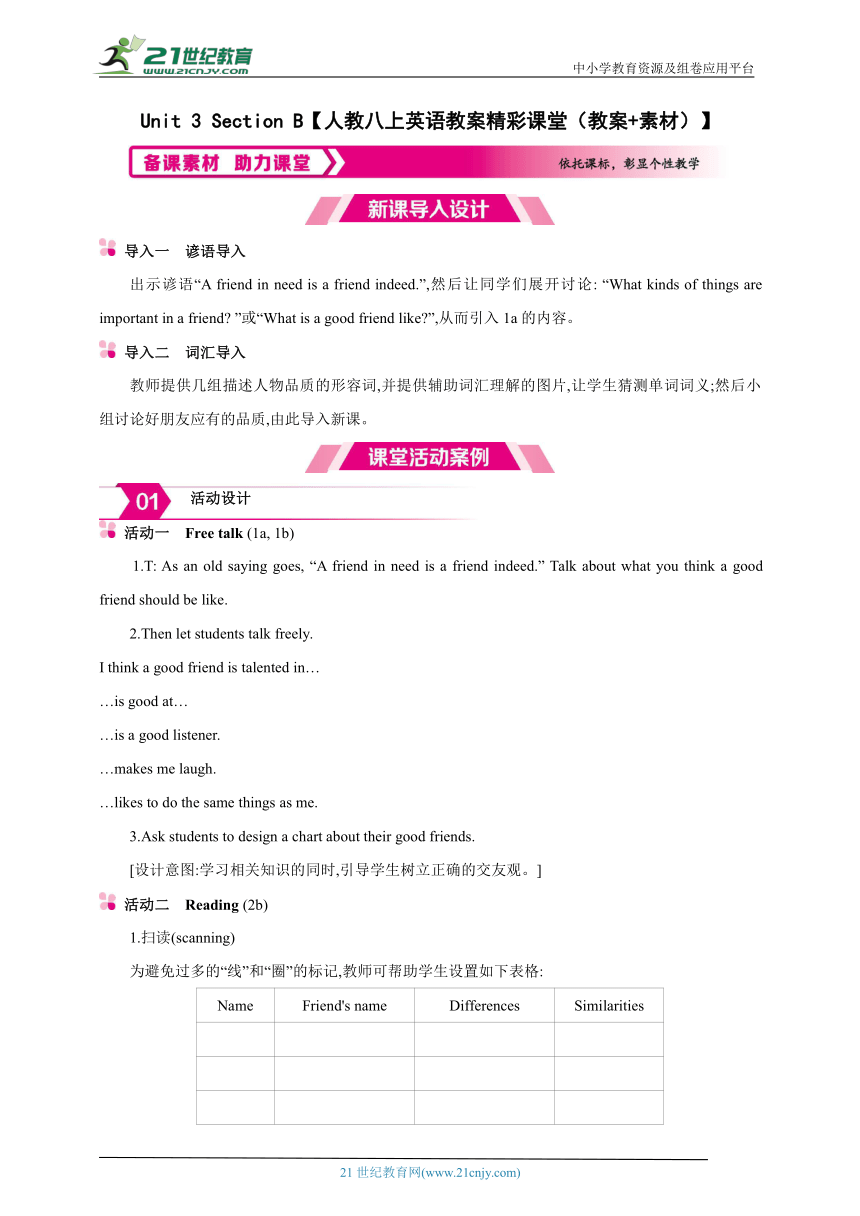 | |
| 格式 | docx | ||
| 文件大小 | 515.7KB | ||
| 资源类型 | 试卷 | ||
| 版本资源 | 人教新目标(Go for it)版 | ||
| 科目 | 英语 | ||
| 更新时间 | 2024-09-02 11:34:57 | ||
图片预览

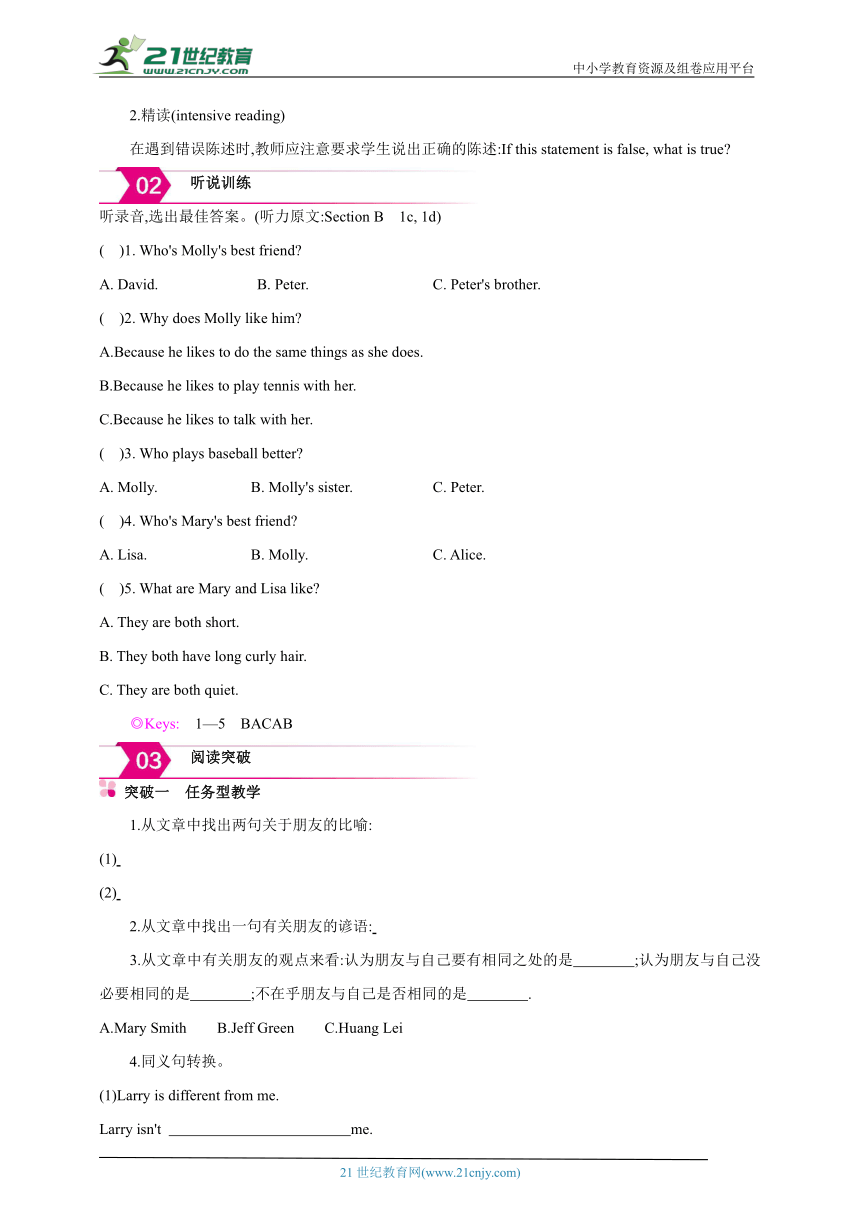
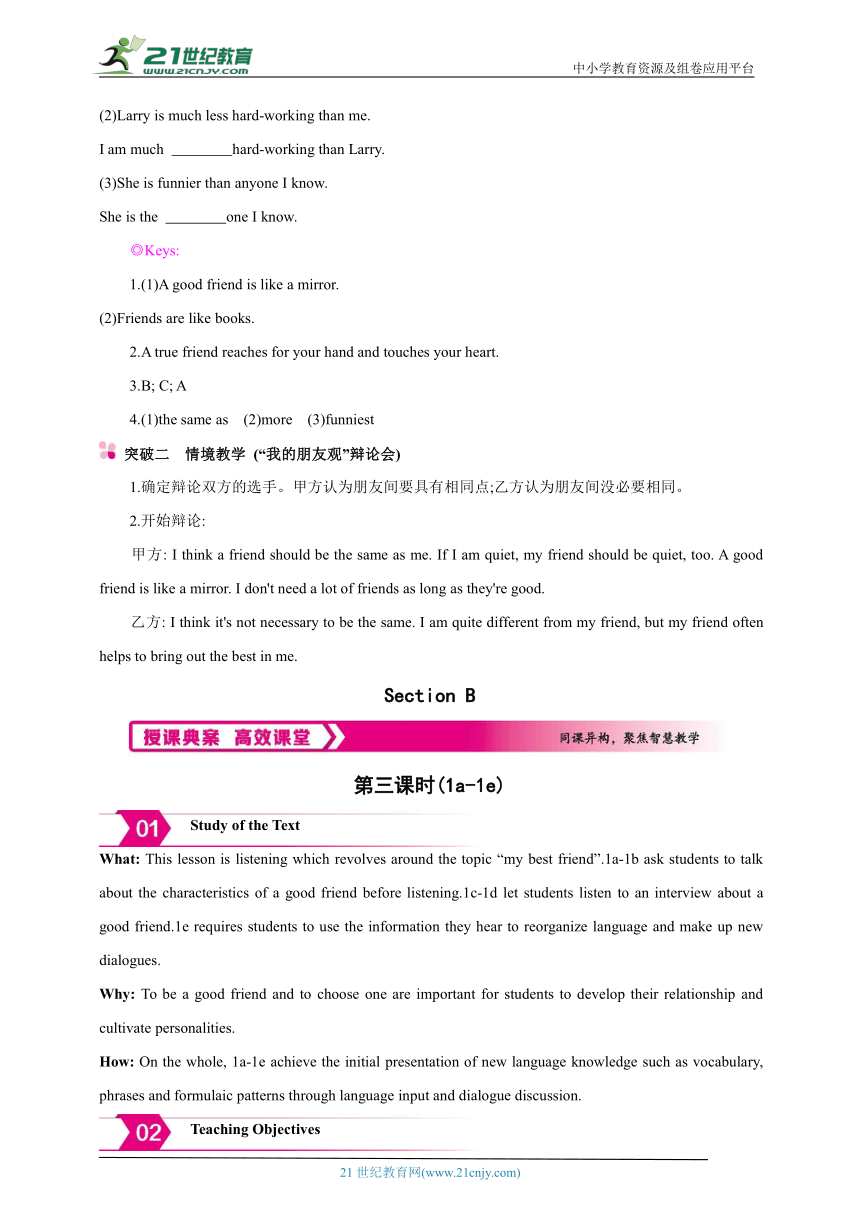
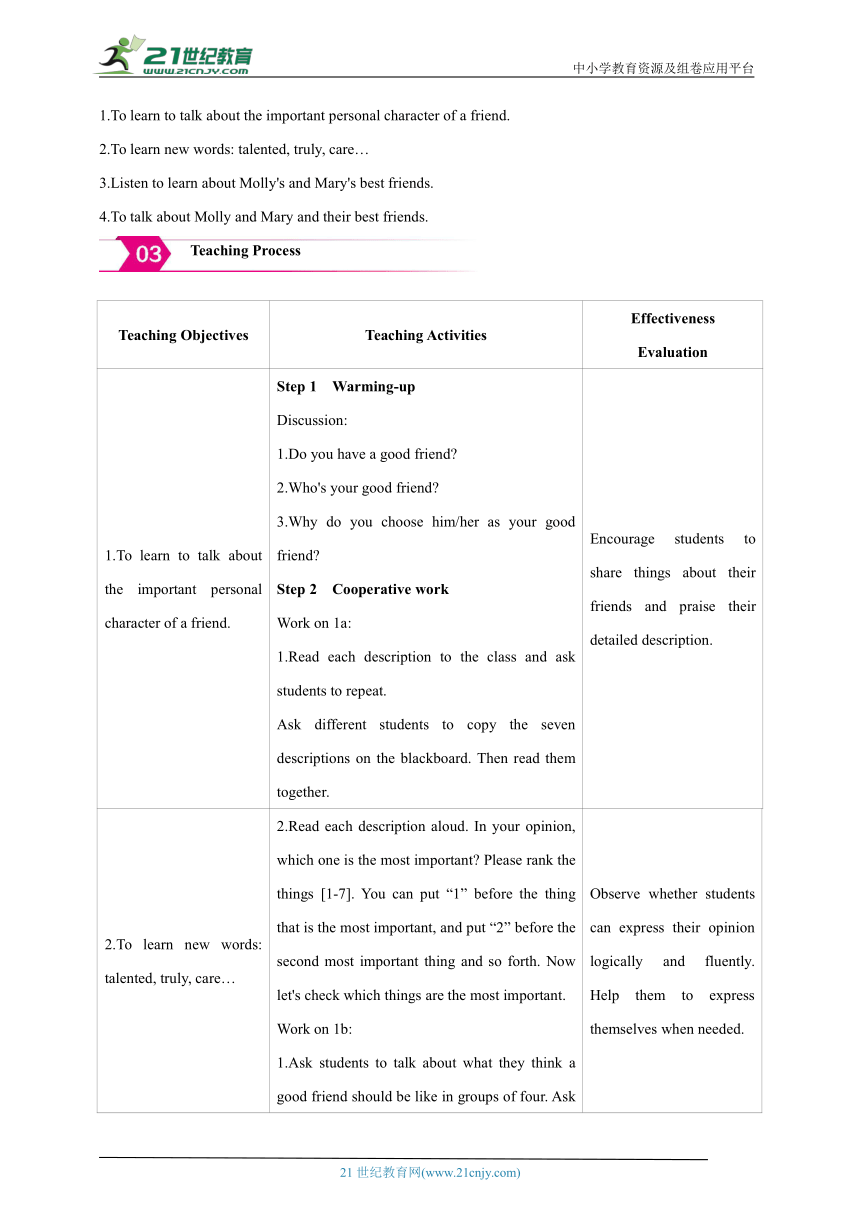
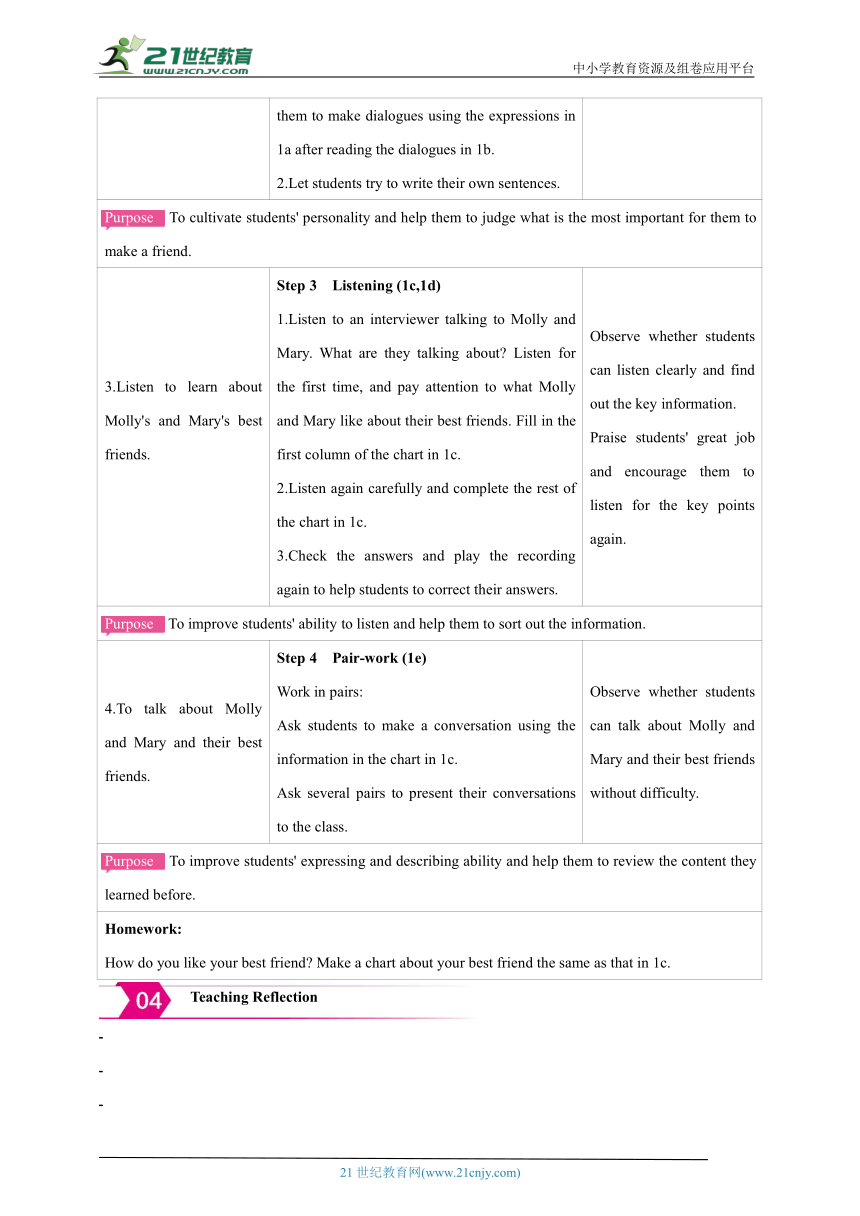
文档简介
中小学教育资源及组卷应用平台
Unit 3 Section B【人教八上英语教案精彩课堂(教案+素材)】
导入一 谚语导入
出示谚语“A friend in need is a friend indeed.”,然后让同学们展开讨论: “What kinds of things are important in a friend ”或“What is a good friend like ”,从而引入1a的内容。
导入二 词汇导入
教师提供几组描述人物品质的形容词,并提供辅助词汇理解的图片,让学生猜测单词词义;然后小组讨论好朋友应有的品质,由此导入新课。
活动设计
活动一 Free talk (1a, 1b)
1.T: As an old saying goes, “A friend in need is a friend indeed.” Talk about what you think a good friend should be like.
2.Then let students talk freely.
I think a good friend is talented in…
…is good at…
…is a good listener.
…makes me laugh.
…likes to do the same things as me.
3.Ask students to design a chart about their good friends.
[设计意图:学习相关知识的同时,引导学生树立正确的交友观。]
活动二 Reading (2b)
1.扫读(scanning)
为避免过多的“线”和“圈”的标记,教师可帮助学生设置如下表格:
Name Friend's name Differences Similarities
2.精读(intensive reading)
在遇到错误陈述时,教师应注意要求学生说出正确的陈述:If this statement is false, what is true
听说训练
听录音,选出最佳答案。(听力原文:Section B 1c, 1d)
( )1. Who's Molly's best friend
A. David. B. Peter. C. Peter's brother.
( )2. Why does Molly like him
A.Because he likes to do the same things as she does.
B.Because he likes to play tennis with her.
C.Because he likes to talk with her.
( )3. Who plays baseball better
A. Molly. B. Molly's sister. C. Peter.
( )4. Who's Mary's best friend
A. Lisa. B. Molly. C. Alice.
( )5. What are Mary and Lisa like
A. They are both short.
B. They both have long curly hair.
C. They are both quiet.
◎Keys: 1—5 BACAB
阅读突破
突破一 任务型教学
1.从文章中找出两句关于朋友的比喻:
(1)
(2)
2.从文章中找出一句有关朋友的谚语:
3.从文章中有关朋友的观点来看:认为朋友与自己要有相同之处的是 ;认为朋友与自己没必要相同的是 ;不在乎朋友与自己是否相同的是 .
A.Mary Smith B.Jeff Green C.Huang Lei
4.同义句转换。
(1)Larry is different from me.
Larry isn't me.
(2)Larry is much less hard-working than me.
I am much hard-working than Larry.
(3)She is funnier than anyone I know.
She is the one I know.
◎Keys:
1.(1)A good friend is like a mirror.
(2)Friends are like books.
2.A true friend reaches for your hand and touches your heart.
3.B; C; A
4.(1)the same as (2)more (3)funniest
突破二 情境教学 (“我的朋友观”辩论会)
1.确定辩论双方的选手。甲方认为朋友间要具有相同点;乙方认为朋友间没必要相同。
2.开始辩论:
甲方: I think a friend should be the same as me. If I am quiet, my friend should be quiet, too. A good friend is like a mirror. I don't need a lot of friends as long as they're good.
乙方: I think it's not necessary to be the same. I am quite different from my friend, but my friend often helps to bring out the best in me.
Section B
第三课时(1a-1e)
Study of the Text
What: This lesson is listening which revolves around the topic “my best friend”.1a-1b ask students to talk about the characteristics of a good friend before listening.1c-1d let students listen to an interview about a good friend.1e requires students to use the information they hear to reorganize language and make up new dialogues.
Why: To be a good friend and to choose one are important for students to develop their relationship and cultivate personalities.
How: On the whole, 1a-1e achieve the initial presentation of new language knowledge such as vocabulary, phrases and formulaic patterns through language input and dialogue discussion.
Teaching Objectives
1.To learn to talk about the important personal character of a friend.
2.To learn new words: talented, truly, care…
3.Listen to learn about Molly's and Mary's best friends.
4.To talk about Molly and Mary and their best friends.
Teaching Process
Teaching Objectives Teaching Activities Effectiveness Evaluation
1.To learn to talk about the important personal character of a friend. Step 1 Warming-up Discussion: 1.Do you have a good friend 2.Who's your good friend 3.Why do you choose him/her as your good friend Step 2 Cooperative work Work on 1a: 1.Read each description to the class and ask students to repeat. Ask different students to copy the seven descriptions on the blackboard. Then read them together. Encourage students to share things about their friends and praise their detailed description.
2.To learn new words: talented, truly, care… 2.Read each description aloud. In your opinion, which one is the most important Please rank the things [1-7]. You can put “1” before the thing that is the most important, and put “2” before the second most important thing and so forth. Now let's check which things are the most important. Work on 1b: 1.Ask students to talk about what they think a good friend should be like in groups of four. Ask them to make dialogues using the expressions in 1a after reading the dialogues in 1b. 2.Let students try to write their own sentences. Observe whether students can express their opinion logically and fluently. Help them to express themselves when needed.
Purpose To cultivate students' personality and help them to judge what is the most important for them to make a friend.
3.Listen to learn about Molly's and Mary's best friends. Step 3 Listening (1c,1d) 1.Listen to an interviewer talking to Molly and Mary. What are they talking about Listen for the first time, and pay attention to what Molly and Mary like about their best friends. Fill in the first column of the chart in 1c. 2.Listen again carefully and complete the rest of the chart in 1c. 3.Check the answers and play the recording again to help students to correct their answers. Observe whether students can listen clearly and find out the key information. Praise students' great job and encourage them to listen for the key points again.
Purpose To improve students' ability to listen and help them to sort out the information.
4.To talk about Molly and Mary and their best friends. Step 4 Pair-work (1e) Work in pairs: Ask students to make a conversation using the information in the chart in 1c. Ask several pairs to present their conversations to the class. Observe whether students can talk about Molly and Mary and their best friends without difficulty.
Purpose To improve students' expressing and describing ability and help them to review the content they learned before.
Homework: How do you like your best friend Make a chart about your best friend the same as that in 1c.
Teaching Reflection
第四课时(2a-2e)
Study of the Text
What: This lesson is reading which shows different opinions on best friends.
Why: To help students realize that there is no standard of best friends as well as improve students' ability to read and get information.
How: Three reading materials will be used to convey different opinions. Writing and talking will be required to express students' own opinions.
Teaching Objectives
1.To learn the key words and expressions: serious, mirror, kid, as long as, necessary, be different from, bring out, grade, should, the same as, saying, reach, hand, touch, heart, fact, in fact, break, arm, share, loud, similar, be similar to.
2.To master the key sentences.
3.To learn how to read and finish the task.
4.To write after reading.
Teaching Process
Teaching Objectives Teaching Activities Effectiveness Evaluation
1.To learn the key words and expres-sions. Step 1 Revision Review the words and key points students learned in the last lesson. Step 2 Warming-up and lead-in 1.Free talk: What do you think a good friend should be like 2.The teacher summarizes the words students talk about and write them on the blackboard. Observe whether students have memorized all the words. Observe whether there are some students who have difficulty expressing their ideas.
2.To master the key sentences. 3.Ask students to write the comparative forms of the adjectives in 2a. Then ask students to use them to make five sentences about themselves and their friends. Pay attention to leading them in the following steps.
Purpose To make sure students have mastered the key points they learned in the last lesson and improve their sharing and describing ability.
3.To learn how to read and finish the task. Step 3 While-reading (2b) 1.Quick reading (1)Ask students to read the passages quickly and know about the three people's ideas about friends. (2)Work on 2b: Ask students to find out different people's opinions and underline the comparative words and phrases in the passages. 2.Intensive reading (1)Ask students to read the passages carefully and find the differences and similarities between friends. (2)Work on 2c: Are the statements true or false Observe whether students can find out the comparative words and phrases. Observe whether students can make right judge-ment and find the origin of the statements.
Purpose To improve students' ability to find the topic, which is useful for students to find the main idea.
4.To write after reading. Step 4 Post-reading Work on 2d: 1.How do you and your friends compare with the people in the article Write five sentences. 2.Invite some students to share what they write. Work on 2e: 1.Which saying about friends is your favorite Which friend do you think of when you read this saying Why Tell your partner about it. 2.Invite some students to share their opinions. Observe whether students can write sentences with right grammar. Praise students' accumu-lation of sayings and expressions. Encourage them to accumulate more.
(续表)
Purpose To lead students to practice what they learned in reading and cultivate their writing skills.
Homework: Draw a picture of you and your best friend with noticeable features and give explanation in English about your similarities and differences.
Teaching Reflection
第五课时(3a-4)
Study of the Text
What: The writing topic of this lesson is to compare yourself with your best friend.
Why: Comparing is helpful for students to learn about themselves and their friends better and match different people with right jobs.
How: First, an introduction to two friends will be given as an example for students to compare. Then they will be required to write by themselves.
Teaching Objective
To learn to write about your friends with comparatives.
Teaching Process
Teaching Objective Teaching Activities Effectiveness Evaluation
To learn to write about your friends with com-paratives. Step 1 Warming-up and revision 1.Have a dictation of the new words and expressions. 2.Ask some students to compare themselves and their deskmates. Step 2 Presentation 1.Show some pictures of the students. Then describe them. 2.Let some students describe the people on the screen. Step 3 Writing guide (3a) 1.Ask students to look at the chart in 3a and compare the two girls. Observe whether students can write down what they learned in the last lesson. Applaud their sharing and praise them for the key words they used in their expressions.
2.Ask students to read the descriptions in the chart and find out the two girls' similarities and differences. 3.Let students try to write sentences and then put them in paragraphs. 4.Invite some students to show their writing. Step 4 Writing Work on 3b: 1.Think of your friends. Make notes about two of them. One friend should be similar to you; the other friend should be different. 2.Give some examples: popular, outgoing, serious, hard-working, tall, thin, has long/short straight hair… Work on 3c: 1.Write two paragraphs describing your friends. 2.Exchange your paragraphs with your partners and make a comment on their writing. Step 5 Practice 1.Give another writing task. 2.Lead students to accumulate writing vocabulary and organize their writing structure. Step 6 Work on exercise 4 1.Read the job ad. 2.Discussion: What kind of person is qualified for the job according to the requirements Observe whether students can sort out the infor-mation and describe it correctly. Observe how much time students spend in thinking and give them some tips in time for fluent writing. Observe whether students know how to evaluate and instruct them in time.
Purpose To help students to practice the ability to learn about personal traits in reality and improve their judgement skills.
Homework: Summarize vocabulary and key points in cooperation with your classmates.
Teaching Reflection
21世纪教育网 www.21cnjy.com 精品试卷·第 2 页 (共 2 页)
21世纪教育网(www.21cnjy.com)
Unit 3 Section B【人教八上英语教案精彩课堂(教案+素材)】
导入一 谚语导入
出示谚语“A friend in need is a friend indeed.”,然后让同学们展开讨论: “What kinds of things are important in a friend ”或“What is a good friend like ”,从而引入1a的内容。
导入二 词汇导入
教师提供几组描述人物品质的形容词,并提供辅助词汇理解的图片,让学生猜测单词词义;然后小组讨论好朋友应有的品质,由此导入新课。
活动设计
活动一 Free talk (1a, 1b)
1.T: As an old saying goes, “A friend in need is a friend indeed.” Talk about what you think a good friend should be like.
2.Then let students talk freely.
I think a good friend is talented in…
…is good at…
…is a good listener.
…makes me laugh.
…likes to do the same things as me.
3.Ask students to design a chart about their good friends.
[设计意图:学习相关知识的同时,引导学生树立正确的交友观。]
活动二 Reading (2b)
1.扫读(scanning)
为避免过多的“线”和“圈”的标记,教师可帮助学生设置如下表格:
Name Friend's name Differences Similarities
2.精读(intensive reading)
在遇到错误陈述时,教师应注意要求学生说出正确的陈述:If this statement is false, what is true
听说训练
听录音,选出最佳答案。(听力原文:Section B 1c, 1d)
( )1. Who's Molly's best friend
A. David. B. Peter. C. Peter's brother.
( )2. Why does Molly like him
A.Because he likes to do the same things as she does.
B.Because he likes to play tennis with her.
C.Because he likes to talk with her.
( )3. Who plays baseball better
A. Molly. B. Molly's sister. C. Peter.
( )4. Who's Mary's best friend
A. Lisa. B. Molly. C. Alice.
( )5. What are Mary and Lisa like
A. They are both short.
B. They both have long curly hair.
C. They are both quiet.
◎Keys: 1—5 BACAB
阅读突破
突破一 任务型教学
1.从文章中找出两句关于朋友的比喻:
(1)
(2)
2.从文章中找出一句有关朋友的谚语:
3.从文章中有关朋友的观点来看:认为朋友与自己要有相同之处的是 ;认为朋友与自己没必要相同的是 ;不在乎朋友与自己是否相同的是 .
A.Mary Smith B.Jeff Green C.Huang Lei
4.同义句转换。
(1)Larry is different from me.
Larry isn't me.
(2)Larry is much less hard-working than me.
I am much hard-working than Larry.
(3)She is funnier than anyone I know.
She is the one I know.
◎Keys:
1.(1)A good friend is like a mirror.
(2)Friends are like books.
2.A true friend reaches for your hand and touches your heart.
3.B; C; A
4.(1)the same as (2)more (3)funniest
突破二 情境教学 (“我的朋友观”辩论会)
1.确定辩论双方的选手。甲方认为朋友间要具有相同点;乙方认为朋友间没必要相同。
2.开始辩论:
甲方: I think a friend should be the same as me. If I am quiet, my friend should be quiet, too. A good friend is like a mirror. I don't need a lot of friends as long as they're good.
乙方: I think it's not necessary to be the same. I am quite different from my friend, but my friend often helps to bring out the best in me.
Section B
第三课时(1a-1e)
Study of the Text
What: This lesson is listening which revolves around the topic “my best friend”.1a-1b ask students to talk about the characteristics of a good friend before listening.1c-1d let students listen to an interview about a good friend.1e requires students to use the information they hear to reorganize language and make up new dialogues.
Why: To be a good friend and to choose one are important for students to develop their relationship and cultivate personalities.
How: On the whole, 1a-1e achieve the initial presentation of new language knowledge such as vocabulary, phrases and formulaic patterns through language input and dialogue discussion.
Teaching Objectives
1.To learn to talk about the important personal character of a friend.
2.To learn new words: talented, truly, care…
3.Listen to learn about Molly's and Mary's best friends.
4.To talk about Molly and Mary and their best friends.
Teaching Process
Teaching Objectives Teaching Activities Effectiveness Evaluation
1.To learn to talk about the important personal character of a friend. Step 1 Warming-up Discussion: 1.Do you have a good friend 2.Who's your good friend 3.Why do you choose him/her as your good friend Step 2 Cooperative work Work on 1a: 1.Read each description to the class and ask students to repeat. Ask different students to copy the seven descriptions on the blackboard. Then read them together. Encourage students to share things about their friends and praise their detailed description.
2.To learn new words: talented, truly, care… 2.Read each description aloud. In your opinion, which one is the most important Please rank the things [1-7]. You can put “1” before the thing that is the most important, and put “2” before the second most important thing and so forth. Now let's check which things are the most important. Work on 1b: 1.Ask students to talk about what they think a good friend should be like in groups of four. Ask them to make dialogues using the expressions in 1a after reading the dialogues in 1b. 2.Let students try to write their own sentences. Observe whether students can express their opinion logically and fluently. Help them to express themselves when needed.
Purpose To cultivate students' personality and help them to judge what is the most important for them to make a friend.
3.Listen to learn about Molly's and Mary's best friends. Step 3 Listening (1c,1d) 1.Listen to an interviewer talking to Molly and Mary. What are they talking about Listen for the first time, and pay attention to what Molly and Mary like about their best friends. Fill in the first column of the chart in 1c. 2.Listen again carefully and complete the rest of the chart in 1c. 3.Check the answers and play the recording again to help students to correct their answers. Observe whether students can listen clearly and find out the key information. Praise students' great job and encourage them to listen for the key points again.
Purpose To improve students' ability to listen and help them to sort out the information.
4.To talk about Molly and Mary and their best friends. Step 4 Pair-work (1e) Work in pairs: Ask students to make a conversation using the information in the chart in 1c. Ask several pairs to present their conversations to the class. Observe whether students can talk about Molly and Mary and their best friends without difficulty.
Purpose To improve students' expressing and describing ability and help them to review the content they learned before.
Homework: How do you like your best friend Make a chart about your best friend the same as that in 1c.
Teaching Reflection
第四课时(2a-2e)
Study of the Text
What: This lesson is reading which shows different opinions on best friends.
Why: To help students realize that there is no standard of best friends as well as improve students' ability to read and get information.
How: Three reading materials will be used to convey different opinions. Writing and talking will be required to express students' own opinions.
Teaching Objectives
1.To learn the key words and expressions: serious, mirror, kid, as long as, necessary, be different from, bring out, grade, should, the same as, saying, reach, hand, touch, heart, fact, in fact, break, arm, share, loud, similar, be similar to.
2.To master the key sentences.
3.To learn how to read and finish the task.
4.To write after reading.
Teaching Process
Teaching Objectives Teaching Activities Effectiveness Evaluation
1.To learn the key words and expres-sions. Step 1 Revision Review the words and key points students learned in the last lesson. Step 2 Warming-up and lead-in 1.Free talk: What do you think a good friend should be like 2.The teacher summarizes the words students talk about and write them on the blackboard. Observe whether students have memorized all the words. Observe whether there are some students who have difficulty expressing their ideas.
2.To master the key sentences. 3.Ask students to write the comparative forms of the adjectives in 2a. Then ask students to use them to make five sentences about themselves and their friends. Pay attention to leading them in the following steps.
Purpose To make sure students have mastered the key points they learned in the last lesson and improve their sharing and describing ability.
3.To learn how to read and finish the task. Step 3 While-reading (2b) 1.Quick reading (1)Ask students to read the passages quickly and know about the three people's ideas about friends. (2)Work on 2b: Ask students to find out different people's opinions and underline the comparative words and phrases in the passages. 2.Intensive reading (1)Ask students to read the passages carefully and find the differences and similarities between friends. (2)Work on 2c: Are the statements true or false Observe whether students can find out the comparative words and phrases. Observe whether students can make right judge-ment and find the origin of the statements.
Purpose To improve students' ability to find the topic, which is useful for students to find the main idea.
4.To write after reading. Step 4 Post-reading Work on 2d: 1.How do you and your friends compare with the people in the article Write five sentences. 2.Invite some students to share what they write. Work on 2e: 1.Which saying about friends is your favorite Which friend do you think of when you read this saying Why Tell your partner about it. 2.Invite some students to share their opinions. Observe whether students can write sentences with right grammar. Praise students' accumu-lation of sayings and expressions. Encourage them to accumulate more.
(续表)
Purpose To lead students to practice what they learned in reading and cultivate their writing skills.
Homework: Draw a picture of you and your best friend with noticeable features and give explanation in English about your similarities and differences.
Teaching Reflection
第五课时(3a-4)
Study of the Text
What: The writing topic of this lesson is to compare yourself with your best friend.
Why: Comparing is helpful for students to learn about themselves and their friends better and match different people with right jobs.
How: First, an introduction to two friends will be given as an example for students to compare. Then they will be required to write by themselves.
Teaching Objective
To learn to write about your friends with comparatives.
Teaching Process
Teaching Objective Teaching Activities Effectiveness Evaluation
To learn to write about your friends with com-paratives. Step 1 Warming-up and revision 1.Have a dictation of the new words and expressions. 2.Ask some students to compare themselves and their deskmates. Step 2 Presentation 1.Show some pictures of the students. Then describe them. 2.Let some students describe the people on the screen. Step 3 Writing guide (3a) 1.Ask students to look at the chart in 3a and compare the two girls. Observe whether students can write down what they learned in the last lesson. Applaud their sharing and praise them for the key words they used in their expressions.
2.Ask students to read the descriptions in the chart and find out the two girls' similarities and differences. 3.Let students try to write sentences and then put them in paragraphs. 4.Invite some students to show their writing. Step 4 Writing Work on 3b: 1.Think of your friends. Make notes about two of them. One friend should be similar to you; the other friend should be different. 2.Give some examples: popular, outgoing, serious, hard-working, tall, thin, has long/short straight hair… Work on 3c: 1.Write two paragraphs describing your friends. 2.Exchange your paragraphs with your partners and make a comment on their writing. Step 5 Practice 1.Give another writing task. 2.Lead students to accumulate writing vocabulary and organize their writing structure. Step 6 Work on exercise 4 1.Read the job ad. 2.Discussion: What kind of person is qualified for the job according to the requirements Observe whether students can sort out the infor-mation and describe it correctly. Observe how much time students spend in thinking and give them some tips in time for fluent writing. Observe whether students know how to evaluate and instruct them in time.
Purpose To help students to practice the ability to learn about personal traits in reality and improve their judgement skills.
Homework: Summarize vocabulary and key points in cooperation with your classmates.
Teaching Reflection
21世纪教育网 www.21cnjy.com 精品试卷·第 2 页 (共 2 页)
21世纪教育网(www.21cnjy.com)
同课章节目录
- Unit 1 Where did you go on vacation?
- Section A
- Section B
- Unit 2 How often do you exercise?
- Section A
- Section B
- Unit 3 I'm more outgoing than my sister.
- Section A
- Section B
- Unit 4 What's the best movie theater?
- Section A
- Section B
- Unit 5 Do you want to watch a game show?
- Section A
- Section B
- Unit 6 I'm going to study computer science.
- Section A
- Section B
- Unit 7 Will people have robots?
- Section A
- Section B
- Unit 8 How do you make a banana milk shake?
- Section A
- Section B
- Unit 9 Can you come to my party?
- Section A
- Section B
- Unit 10 If you go to the party, you'll have a grea
- Section A
- Section B
